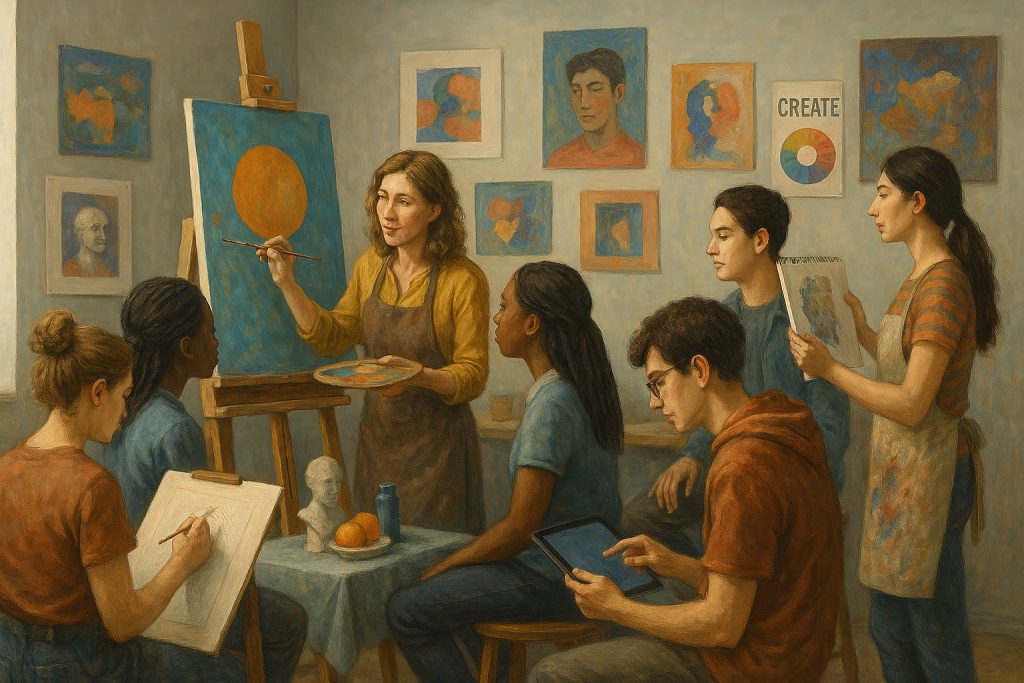Introduction
Teaching visual arts involves a variety of methodologies that encourage creativity, technical skill development, and artistic expression. However, mastering the best instructional techniques can be challenging for educators and students alike. This Teaching Methods in Visual Arts homework help guide explores effective strategies, lesson planning tips, and valuable external resources to aid in visual arts education.

Understanding Teaching Methods in Visual Arts
Teaching methods in visual arts vary based on artistic disciplines, student age groups, and educational goals. The primary approaches include direct instruction, experiential learning, and inquiry-based methods.
1. Direct Instruction
Direct instruction involves structured lessons where teachers demonstrate techniques and students practice them under guidance.
- Key Tip: Start with foundational techniques before advancing to complex skills.
- Resource: The Kennedy Center’s ArtsEdge provides lesson plans and tutorials.
2. Experiential Learning
This method encourages hands-on exploration, allowing students to experiment with different materials and styles.
- Key Tip: Incorporate real-world art experiences such as gallery visits or guest artist workshops.
- Resource: National Art Education Association offers valuable professional development insights.
3. Inquiry-Based Learning
Inquiry-based learning encourages students to develop critical thinking and problem-solving skills through artistic projects.
- Key Tip: Ask open-ended questions to prompt deeper analysis of artistic concepts.
- Resource: Harvard’s Project Zero provides research-based strategies for creative thinking in the arts.
Common Challenges in Teaching Visual Arts
Many students and educators face challenges such as:
- Limited Resources – Access to quality art supplies can be a barrier.
- Creative Blocks – Encouraging originality while teaching technical skills is essential.
- Assessment Difficulties – Evaluating art objectively can be complex.
Strategies for Effective Visual Arts Teaching
- Incorporate Technology – Digital tools and software enhance artistic exploration.
- Encourage Artistic Freedom – Balance technical instruction with creative expression.
- Use Cross-Disciplinary Approaches – Integrating art with history, science, and literature broadens perspectives.
- Provide Constructive Criticism – Focus feedback on both strengths and areas for improvement.
- Promote Collaborative Projects – Group work fosters teamwork and diverse artistic interpretations.
Analyzing Notable Teaching Methods in Visual Arts
1. The Bauhaus Approach
- Teaching Elements: Interdisciplinary learning, craftsmanship, and modernism.
- Famous Quote: “Art and technology—a new unity.”
- Lesson: Combining multiple disciplines enriches artistic education.
2. Montessori Art Education
- Teaching Elements: Student-led learning and hands-on activities.
- Famous Quote: “Follow the child.”
- Lesson: Encouraging independent exploration fosters creativity.
3. The Reggio Emilia Approach
- Teaching Elements: Project-based learning and emphasis on process over product.
- Famous Quote: “Children have a hundred languages.”
- Lesson: Encouraging multiple forms of artistic expression enhances learning.
How to Excel in Teaching Methods in Visual Arts Assignments
- Understand Different Methodologies – Research and compare various teaching styles.
- Incorporate Art History – Understanding historical context enhances teaching effectiveness.
- Use Case Studies – Analyzing real-world examples provides deeper insight.
- Experiment with Different Mediums – Exposure to various materials fosters adaptability.
- Reflect on Teaching Practices – Continuous improvement enhances instructional quality.
Recommended External Resources for Teaching Methods in Visual Arts Homework Help
- Smithsonian Learning Lab – Free access to educational art resources.
- Tate Kids – Interactive resources for young artists.
- Getty Museum’s Education Portal – Lesson plans and teaching strategies.
- Khan Academy – Art History – Provides structured courses on art history and techniques.
Conclusion
Teaching methods in visual arts require a balance of structure, creativity, and student engagement. By applying diverse instructional techniques, incorporating modern technology, and utilizing expert resources, educators can enhance the learning experience. This Teaching Methods in Visual Arts homework help guide provides essential tools for students and teachers to succeed in the field of visual arts education.


